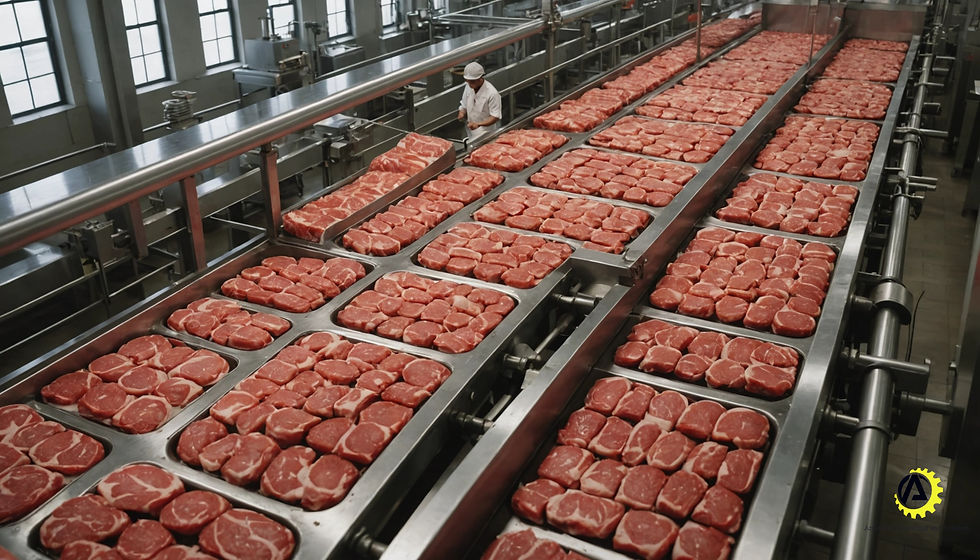How to Select the Best Beef Meat Production Line for Your Operation: A Complete Guide
- Amindus Consulting and Solutions
- Jan 28
- 4 min read
Presented by Amindus Consulting and Solutions
Navigating the beef meat production industry can be complex. The right production line impacts not just efficiency but also the quality and profitability of your business. With different options available, it's crucial to evaluate each carefully. This guide will help you compare various beef meat production lines based on their features, costs, and performance, so you can make a well-informed decision for your operation.
Understanding Beef Meat Production Lines
Beef meat production lines differ in processing capabilities, equipment types, and technological advancements. Some lines focus on large-scale operations, while others target smaller enterprises that cater to niche markets. By understanding these differences, you can save costs and improve product quality.
Types of Beef Meat Production Lines
Conventional Production Line
The conventional beef production line is the standard setup for many meat producers. Designed for high throughput, these lines feature automation that minimizes manual work. For instance, a typical conventional line can process up to 300 cattle per hour, ensuring a swift turnaround.
Artisanal Production Line
This production line maintains traditional methods to ensure superior meat quality. Artisanal lines prioritize craftsmanship over speed. For example, producers may focus on hand-cutting, which appeals to consumers willing to pay a premium—often 20-30% more than standard products—in exchange for quality.
Robotic Production Line
Robotic lines utilize technology for tasks such as cutting and packaging. For example, robotic systems can operate continuously, producing up to 25% more meat compared to conventional lines. However, the initial setup cost can be substantial, often exceeding $1 million.
Features of Different Beef Meat Production Lines
Each production line has unique features affecting performance and efficiency. Grasping these features will allow for a clearer decision-making process.
Conventional Production Line Features
Standardized Machines: Includes conveyor belts, cutting machines, and packaging systems to streamline processes.
High Throughput: Capable of handling large volumes efficiently, making it ideal for mass production.
Automated Processes: Reduces manual tasks to enhance consistency and speed.
Lower Initial Setup Cost: Typically, setup costs range from $200,000 to $500,000, depending on complexity.
Artisanal Production Line Features
Traditional Methods: Emphasizes craftsmanship, with each cut being carefully executed.
Quality Control: Each piece is often inspected individually, ensuring premium standards.
Niche Appeal: Attracts customers focused on sustainability and quality.
Lower Automation: More manual processes lead to higher labor costs but enhanced product quality.
Robotic Production Line Features
Advanced Technology: Robots ensure precision and consistency in meat cuts.
Increased Efficiency: Can run continuously, significantly boosting production capacity.
Higher Initial Investment: Setup costs can exceed $1 million based on scale.
Reduced Labor Costs: Automation drastically cuts down required personnel.
Cost Considerations
Evaluating the cost implications of each beef meat production line is essential for informed decision-making.
Conventional Production Line Costs
Setup Costs: Ranges from $200,000 to $500,000 based on the line's features.
Maintenance: Generally requires less compared to advanced technology lines.
Labor Costs: Automation reduces but does not eliminate manual labor expenses.
Artisanal Production Line Costs
Initial Investment: Usually lower than robotic lines but varies widely based on equipment.
Labor Costs: Higher due to reliance on skilled, manual processing.
Operational Expenses: Can vary unpredictably with labor and ingredient costs.
Robotic Production Line Costs
High Initial Investment: Costs often exceed $1 million depending on complexity.
Operational Expenses: Typically lower due to reduced workforce needs but requires regular tech updates.
Return on Investment: Potential for high ROI through improved efficiency if demand remains stable.
Performance Comparisons
Analyzing performance factors like output quality, speed, and waste management will help you choose the best production line.
Output Quality
Conventional Lines: Reliable but can vary with human labor involvement.
Artisanal Lines: Known for superior quality due to skilled craftsmanship.
Robotic Lines: Consistent quality through precision technology, though occasional imperfections can occur.
Speed of Production
Conventional Lines: High efficiency makes them suitable for large-scale operations.
Artisanal Lines: Slower, focusing on craftsmanship over speed.
Robotic Lines: Extremely fast, but production can be constrained by storage capacity.
Waste Management
Conventional Lines: Average waste management, usually adhering to standard practices.
Artisanal Lines: Often generate less waste through efficient butchering techniques.
Robotic Lines: Utilize modern waste management systems, recycling by-products more effectively.
Final Thoughts on Production Line Selection
Finding the right beef meat production line can shape your business's future. Each line—conventional, artisanal, or robotic—has unique features, costs, and performance metrics.
Determining your specific business needs and market trends is essential for making the right decision. Understanding the operational requirements and financial implications discussed in this guide will help you select a production line that aligns with your goals.
Ultimately, whether you aim for quality, speed, or cost-effectiveness, your choice will influence your profitability and growth in the highly competitive beef meat industry.







Comments